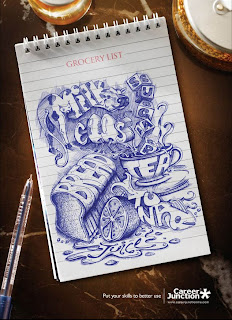Joshua Allen Harris Public Art Video
With in the past year or so I have had an almost unhealthy obsession with lowbrow Public Art, more popularly referred to as street art. There is this driving force within the artwork of this idea that people who have no want to know about art or the people who have “no time” for art are forced to interact with it or even unknowingly participate in it. The idea that at any moment of the day someone is forced to look at this new piece of art that has been turned into real life and really bring art to a practical level to what it is trying to talk about highly interests me.
I know that most if not anyone in the world by now has heard of the famous street artist with the penname Banksy who paints on walls around cities, and yes this form of public art is important in the ideas of what public art has become but I don’t think that public art should be limited to just this for two reasons.
First off just by readings and some video clips (like the one I posted above) has already expanded my knowledge of public art to sculpture, modification of existing objects, instillations, and even signs.
Secondly, I have often struggled with ethics of public art and what should be allowed and what is acceptable. Obviously by law what Bansky does is considered vandalism, along with many other “culture jamming” techniques such as sign manipulation and so on. Setting aside opinions referring to the ethics of this kind of public art and culture jamming I think that the ethics brings up an important question of whether or not public art is actually art at all. This question is too heavy for my response within this post, but I wanted to bring both the points of ethics of public art as well as the involvement of traditional art forms brought into the public while talking about this short clip I recently found on youtube.
The clip is about Joshua Allen Harris and his public art that is inflatable “bag monsters”. He goes about the city and placed his sculptures all around the city and the means of inflation is vents all around the city. This is referred to as public art simply because of aspect of it actually being in the public eye. I find it fascinating because these creatures that are made out of plastic bags come to life and are animated for moments at a time and when the air flows out of them they crumple up and die, just to be left on the ground and look like a useless bag on the pavement.
This series of public art also interests me because it seems that this kind of public artwork seems to be more tolerated than other forms of public art. It essentially is doing the same thing that any other public art piece is doing and it is in the public eye and forcing the people directly around it to interact with it whether they want to or not. Trying to figure out an answer to my question of acceptance I figured that it was because of its originality of what we see street art as and its ability to be pubic art without being an illegal method to produce the work. Which hints at the next question, what makes any public or street art different than a street performer? Or where is the line going to be drawn for advertisements on walls so not every inch of the streets are going to be sold for advertisements to sell us the public things?
“Any advertisement in public space that gives you no choice whether you see it or not is yours. It belongs to you. It's yours to take, rearrange and re-use. Asking for permission is like asking to keep a rock someone just threw at your head.” -Banksy
 I had a hard time finding something that I was interested in blogging about this week. Then I came across the ad for Career Junction. The use of text as image works very well in this ad. The artist used everyday items in their same likeness while defining each with the word in such a clever way. I particularly like that the juice isn’t bottled.
I had a hard time finding something that I was interested in blogging about this week. Then I came across the ad for Career Junction. The use of text as image works very well in this ad. The artist used everyday items in their same likeness while defining each with the word in such a clever way. I particularly like that the juice isn’t bottled.





























